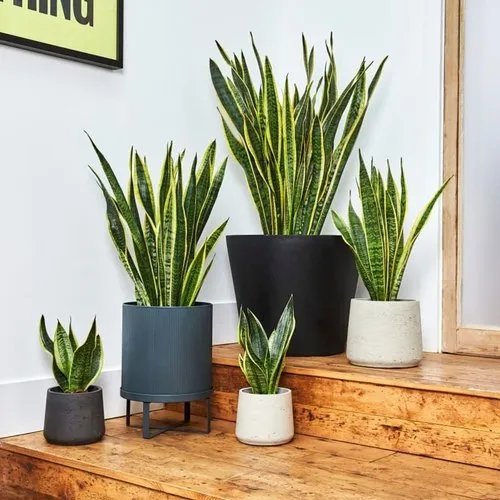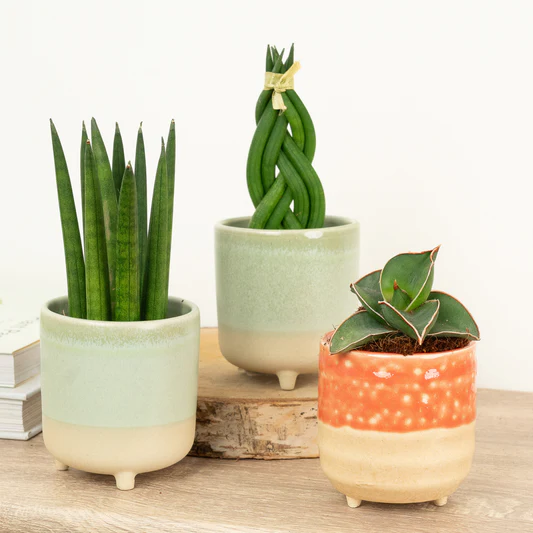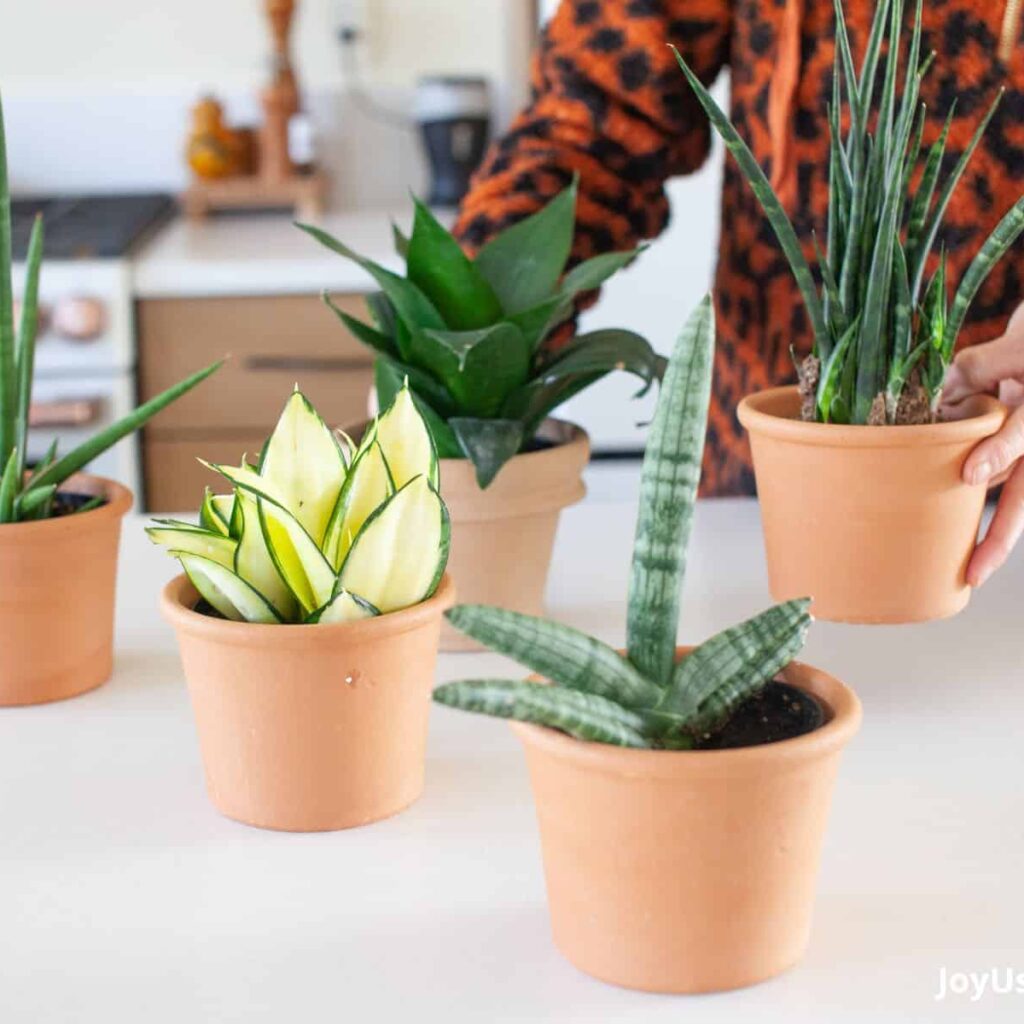If you’re looking for a houseplant that’s virtually indestructible, strikingly beautiful, and fantastic for indoor air quality, the snake plant (also known as Sansevieria or Dracaena trifasciata) deserves a top spot in your home. Its tall, sword-like leaves with variegated patterns make it one of the most stylish and low-maintenance plants available.
In this comprehensive guide, we’ll walk you through everything you need to know about how to take care of a snake plant indoors, from watering and lighting tips to repotting, propagation, and common troubleshooting.
Why Choose a Snake Plant?

Also known as Mother-in-Law’s Tongue, snake plants have surged in popularity for several reasons:
- Extremely low-maintenance and hardy
- Excellent air purifier (removes toxins like benzene, formaldehyde, and xylene)
- Tolerates low light and neglect
- Stylish, modern aesthetic
- Ideal for bedrooms, living rooms, offices, or bathrooms
Even beginner plant parents will find success growing this resilient indoor beauty.
Ideal Growing Conditions for Snake Plants Indoors
Although snake plants are tolerant of a wide range of conditions, they’ll thrive when provided with the right care.
Light Requirements
Snake plants prefer bright, indirect light, but they’re highly adaptable and can tolerate:
- Low-light corners
- Fluorescent-lit offices
- Direct sun for a few hours
Tip: Too much direct sunlight can scorch the leaves, while too little light slows growth.
Temperature and Humidity
- Ideal temperature: 60°F to 85°F (15°C to 29°C)
- Avoid cold drafts and temperatures below 50°F (10°C).
- Snake plants tolerate normal indoor humidity but prefer a moderately dry environment.
Tip: Bathrooms with good light can work well because snake plants handle occasional humidity.
Soil Type
Use a well-draining potting mix.
Cactus or succulent mixes work best because snake plants dislike sitting in waterlogged soil.
Optional mix:
- 2 parts potting soil
- 1 part perlite or coarse sand
This combination improves drainage and prevents root rot.
Pot Selection
Choose a pot with drainage holes to prevent excess water from pooling at the bottom.
Watering Snake Plants Indoors

One of the most common mistakes with snake plants is overwatering.
How Often to Water
- In spring and summer: Every 2-4 weeks
- In fall and winter: Every 4-6 weeks
Allow the soil to completely dry out between waterings.
Check moisture by sticking your finger about an inch into the soil — if it feels dry, it’s time to water.
How to Water
- Water thoroughly until excess drains from the bottom.
- Empty the saucer to prevent root rot.
Tip: Always err on the side of underwatering. Snake plants store water in their leaves and are drought-tolerant.
Fertilizing Your Snake Plant
While snake plants don’t require frequent feeding, occasional fertilizing encourages growth.
When to Fertilize
- During the active growing season (spring and summer).
- Every 2-3 months with a balanced, water-soluble houseplant fertilizer diluted to half strength.
Tip: Avoid fertilizing in fall and winter when growth naturally slows.
Pruning and Cleaning Snake Plants

Pruning helps maintain your snake plant’s appearance and health.
When to Prune
- Remove dead, yellowing, or damaged leaves at the base with clean scissors.
- Cut away overgrown or leggy leaves to reshape the plant.
Cleaning Leaves
Dust can build up on snake plant leaves, blocking light and reducing air-purifying abilities.
How to clean:
- Wipe leaves gently with a damp cloth or sponge.
- Avoid using harsh chemicals.
Repotting Snake Plants
Though snake plants love being slightly root-bound, they’ll eventually outgrow their pots.
When to Repot
- Every 2-3 years, or when roots start poking out of drainage holes or circling the pot.
- Best time: Spring or early summer
How to Repot
- Choose a pot 1-2 inches larger than the current one.
- Gently remove the plant and shake off old soil.
- Replant in fresh, well-draining potting mix.
- Water lightly after repotting.
Tip: Avoid overwatering right after repotting — let the roots settle for a few days.
Propagating Snake Plants

Propagating snake plants is surprisingly easy and a great way to multiply your collection.
Methods of Propagation
- Leaf Cuttings in Water
- Cut a healthy leaf into 3-4 inch sections.
- Place the bottom end in water.
- Change water every few days.
- Roots appear in 3-5 weeks.
- Leaf Cuttings in Soil
- Let cuttings dry for a day.
- Plant upright in moist, well-draining soil.
- Water sparingly until roots form.
- Division
- Remove the entire plant from its pot.
- Separate clumps of leaves and roots.
- Repot each section individually.
Common Snake Plant Problems and Solutions
| Problem | Cause | Solution |
|---|---|---|
| Yellow, mushy leaves | Overwatering, root rot | Remove affected leaves, reduce watering, repot |
| Brown leaf tips | Low humidity, drafts, inconsistent watering | Trim tips, adjust conditions |
| Leaves falling over | Overwatering, poor light, overcrowding | Prune, improve light, or divide plant |
| Leaf discoloration | Excess direct sun or pests | Move to indirect light, check for mealybugs |
Bonus Tips for a Thriving Snake Plant

- Rotate the pot occasionally to promote even growth.
- Avoid misting — snake plants prefer dry air.
- In winter, reduce watering frequency drastically.
- Snake plants are mildly toxic to pets if ingested — keep out of reach of curious cats and dogs.
Why Snake Plants Are Perfect for Beginners
With their sleek, upright leaves and low-maintenance personality, snake plants are a top pick for:
- New plant parents
- Busy professionals
- Small apartments and low-light spaces
- Air-purifying enthusiasts
They tolerate neglect, bounce back from underwatering, and rarely suffer from pests or disease when given basic care.
Final Thoughts
If you’re searching for a houseplant that’s both decorative and nearly impossible to kill, the snake plant is your ideal match. By following these simple care instructions — providing bright indirect light, watering sparingly, and using well-draining soil — you can enjoy a beautiful, thriving plant that adds style, clean air, and a touch of nature to your indoor space.
So grab that sturdy snake plant, place it in a sunny corner, and let its low-maintenance magic enhance your home.




Leave A Comment